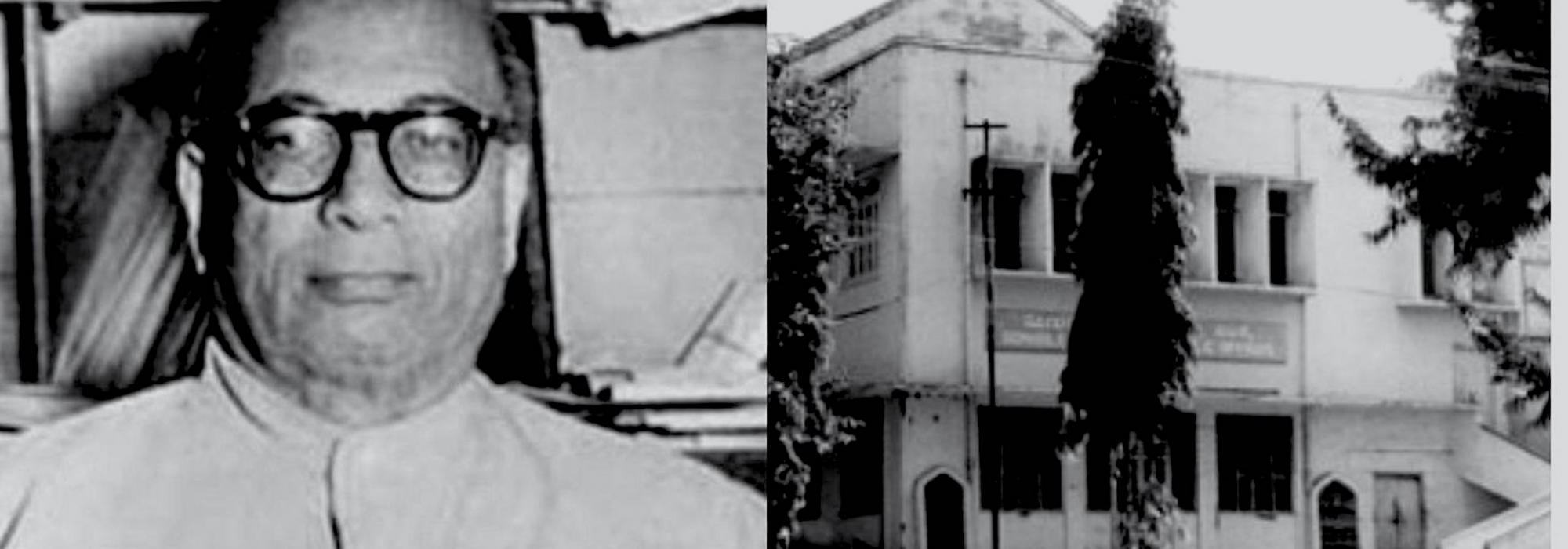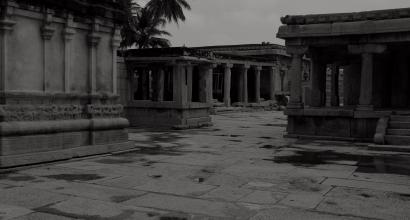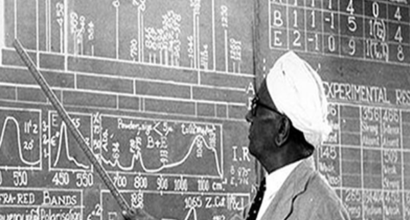beku jīvanayogakoṃdu bahusūkṣmanaya ।
bekoṃdu jāgarūrakate, buddhi samate ॥
tākaneṃdanu yogi, nūkaneṃdanu jagadi ।
ekāki sahavāsi - maṃkutimma ॥ 703 ॥
Happiness in life needs a very fine balance.
It requires utmost caution and tranquility of mind.
Akin to a Yogi, its practitioner will not get attached to anything
Nor will he neither reject anything.
He stands alone while being friends with the entire world – Mankutimma
***
An almost visible line separates DVG’s pre-independence and post-independence public life. After actively cutting himself off from the rough and tumble of political life, DVG devoted himself with the same profound passion and spirited zeal to the more sublime pursuits of philosophy, spirituality, literature, and nationalistic ideals for the rest of his well-lived life.
His devotion to the aforementioned nationalistic ideals took the concrete shape of the Gokhale Institute of Public Affairs (GIPA), which was founded in his home at Nagasandra Road[1] on 18 February 1945. Public response to this new institution was immediate and an overwhelming success. Congratulatory letters and messages and personal visits poured in from both within and outside Karnataka from such eminent people as Gopalaswamy Ayyangar, Sir Mirza M. Ismail, B.P. Wadia, V. Sitaramaiah, K.S. Krishna Iyer, S.G. Sastri, and Nittur Srinivasa Rao.
GIPA was the structural realization of DVG’s three-decade-long penance. Its impulse had germinated in his mind as early as 1915 and he began work on its draft charter 1930. It had the blessings of Sir Puttanna Chetty. However, for various reasons, DVG was unable to raise the funds to begin it. On 30 January 1932, DVG completed the aforementioned draft but expressed[2] self-doubt:
Finished draft scheme of G.I.P.A. As I finish it I am stricken with fear and doubt…Will I be able to bring it into material existence? Can I trust myself to remain steady at it? I have been such a waverer all my life…a bee-like skipper from ideal to ideal.
History is testimony to the fact that he did bring it into existence thirteen years later. Here is how DVG summarizes[3] its entire charter and work:
The Institute is to be looked upon as a laboratory for the analysis and assessment of opinion and policy rather than a factory to produce original contributions to thought and learning or as a platform for propaganda or agitation, or as a mission of philanthropy…It does not aim at supplanting any political party or movement…this Institute would rather leave those other forms of services to other agencies…so that it could give its undivided attention to the particular field of service which it has chosen for itself – namely to be a study-room for intelligent citizenship, an exchange house of thought…for men and women of public spirit and an unofficial secretariat for all good and worthy popular causes.
For an entire year, GIPA functioned from his home even as he put in tireless work at fund-raising and scouting for a building for this infant institution. The goodwill, affection and friendship that he had earned on the dint of his own merit, integrity and selflessness brought him widespread support. Sri Pamadi Subbrama Shetty, one of the fabulously wealthy businessmen in Bangalore was also a highly simple and devout man who gave liberally to all Dharmic causes. Accordingly, he offered one of his homes[4] in Basavanagudi. GIPA officially moved to this location on 1 July 1946. Its first ever meeting was addressed by Hrudyanath Kunzru, the then president of the Servants of India Society.
In October, GIPA began its maiden study circle with the rather apt selection of Plato’s classic, Republic. It was guided by Sri S. Raghavacharya and continued for an entire month. Indeed, the study circle was among the defining themes of GIPA for the next three decades. Like fine honey, over time, it attracted hordes of people from all walks and stations of life: students, working professionals, teachers, lecturers, principals, journalists, scientists, doctors, and businessmen. In keeping with its spirit, there was no age or gender bar. The GIPA study circle was conducted every Sunday morning. About twenty people would come together and study and discuss a preselected English and Sanskrit work each. John Stuart Mill, Kalidasa, Shakespeare, works of Vedanta, and numerous classics of Sanskrit, English and Kannada were devoured with relish. Perhaps the most celebrated study circle was the series of lectures on the Bhagavad Gita led by DVG himself. They were eventually compiled, thoroughly revised, vastly expanded, and published as śrīmad bhāgavadgītātātparya or jīvanadharmayoga in Kannada. It remains an enduring classic till date, garnering several reprints and has a dedicated following among the Kannada people across the globe.
From such modest beginnings, GIPA continued to grow into the awe-inspiring cultural treasure that it since became. On 15 August 1948, Sri B.P. Wadia inaugurated its sparkling new library, freely accessible by public. The GIPA library is still one of the best in the country housing extremely valuable, rare, and priceless books, pamphlets, monographs, magazines, and boasts of an enviable archive of Sanskrit, Kannada, Telugu, Hindi and English works. The finest books on every conceivable subject are available: Vedas, literary classics, drama, art, sculpture, history, politics, philosophy, Dharmashastra, economics, law, geography, biographies, research journals, newspaper archives, periodicals, Constitutions of various countries, Lok Sabha and Rajya Sabha and Karnataka Assembly proceedings…the sweep and gamut is truly stunning. The GIPA library is an invitation to lifelong learning in its truest sense. On another plane, it has that scarce and exquisite ambience that radiates and beckons us to acquire knowledge in its serene environs. As a crowning glory, DVG donated his personal book collection to the GIPA library.
The impulse and vision behind creating such a brilliant library was again rooted in DVG’s foresight that any member of the public who wished to examine, study, speak, or write about public and national issues would have a one-stop resource at GIPA.
The next milestone arrived on 25 April 1950 when the Karnataka Government donated land to GIPA. The finished building was inaugurated on 28 June 1956. Donations for its construction flowed in quite liberally from both individuals and institutions. The current building of GIPA stands on this site.
The other core area of GIPA’s activity was hosting regular lectures by luminaries from different spheres. Thus, in a short time, GIPA was transformed into a vibrant cultural hub that witnessed erudite, scholarly and refined lectures on literature, Vedanta, Bhagavad Gita, jurisprudence, science, economics, music, art, and important contemporary issues. To mention the forgivable fault of a personal account, I still find enormous delight tinged with a bit of nostalgic melancholy when I listen to superb, moving, and inspiring anecdotes surrounding these lectures in the voice of Dr. S.R. Ramaswamy, the last direct disciple of DVG. It is today hard to believe that GIPA in those days would be thronged by hundreds of people who devotedly came to listen to these lectures.
The ranks of admirers, donors, volunteers and contributors to GIPA grew in proportion to the prestige and quality of these programmes. As a memorial to Rajaji’s birth anniversary, Smt. M.S. Subbulakshmi has left an endowment to GIPA. Indeed, there are numerous occasions when she would visit DVG’s home and sing for him, leaving his eyes moist with tears. GIPA is also witness to her concerts. Similar endowments were given by the Kannada poet, G.P. Rajarathnam, Rao Bahadur Venkateshacharya, Justice Nittoor Srinivasa Rao, and the Dharmasthala Manjunatha Temple. These apart, service-minded and culturally-rooted individuals also sponsor these lectures. Initially, these were held every Saturday evening and DVG never missed a single lecture as long as he was alive. Happily, this tradition continues the blazing path seeded by its founder and over the years, they are conducted every evening. The calendar of lectures is published about six months in advance.
The other major focus of GIPA is publishing its monthly journal, the self-explanatory Public Affairs. It is dedicated to examining various contemporary issues relating to politics, economics, and current affairs. Public Affairs began in January 1949 and boasted of an impressive list of stalwarts who wrote for it including its editor DVG, Arnold Toynbee, Bernard Levin, C.D. Deshmukh, Prof G.S. Dikshit, Gorur Ramaswamy Iyengar, Gulzarilal Nanda, Herbert Spencer, Kuldip Nayar, N. Lakshmana Rao, Lord Hailsham, N. Madhava Rao, Minoo Masani, Masti Venkatesha Iyengar, Mirza Ismail, Nani Palkhivala, Philip Spratt, C. Rajagopalachari, Prof B.R. Shenoy, Prof. Suryanath Kamat, Uma Shankar Joshi, and Sir M. Visvesvaraya.
True to its motto of “Public life must be spiritualized,” and its declared stance of “no party affiliation,” month after month, Public Affairs mercilessly skewered the misdoings of the political and bureaucratic class, educated its readers on the meaning of democracy, service, and nationalistic spirit, and sounded frequent alarms over lapses, cautioned about the decline of decency in public life, and brought out valuable insights and essays on history, literature and published book reviews. The volumes of Public Life from its inception up to 1982 are truly a collector’s delight.
The Gokhale Institute of Public Affairs as DVG described it indeed lived up to its vision and practice of being an unofficial secretariat for all good and worthy causes. The testimony to its sturdy roots lies in the fact that it continues to thrive as a cultural and public-spirited institution that has few rivals in Bangalore.
Which brings us to a related facet of DVG’s post-independence work and legacy. By making GIPA both his Karma Bhoomi and Jnana Bhoomi, DVG achieved what he wouldn’t have achieved had he remained in active politics: of being a systematic, truthful, and caustic conscience-keeper of independent India’s political and social conscience. That conscience-keeping essentially meant an honest dissection of the Congress Party, whose only claim to political power was based on the half-truth that it had alone brought freedom from British rule.
To be continued
Notes
[1] Since renamed as DVG Road in his honour
[2] Quoted in Virakta Rashtraka: D.R. Venkataramanan, Navakarnataka, Bangalore, 2019, p 219
[3] Quoted in Virakta Rashtraka: D.R. Venkataramanan, Navakarnataka, Bangalore, 2019, pp 218-9. Emphasis added.
[4] This home was located at the Northeast of M.N. Krishna Rao Park.



































